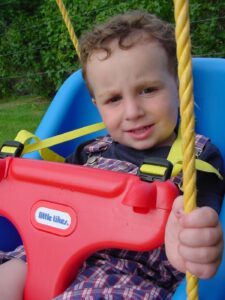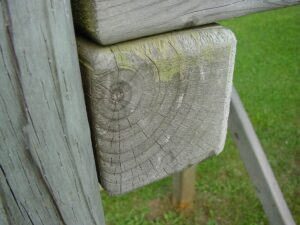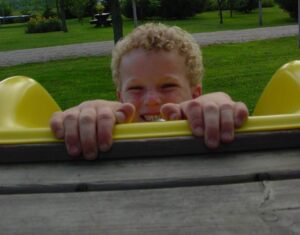In the suburb where I grew up in the early 1970s, almost none of my friends had their own backyard swing set.
The exception was one family with a small metal swing-and-slide combo – the kind with a triangular frame that teetered up on two legs whenever a couple of kids swung too hard in the same direction. But since it was the only game around, this lightweight contraption was always crawling with too many kids.
I’m not sure why homebuilt play sets weren’t popular back when I was a kid, but it’s a good thing they are now. These days there’s plenty of great hardware, tools and ideas to make terrific backyard structures on your own.
But even still, you’ve probably got questions about how to build right. At least you should have questions.
 Getting started
Getting started
You can certainly buy play set kits, but you pay a lot more for a design that’s probably built with lighter materials and hardware than you’d use on your own.
Building your own is not rocket science, either. I designed and built the backyard set you see here for our kids in the 1990s, and it’s still working perfectly today. The only thing I’d change is making the uprights thicker. They work fine, but look a little thin. Even grandchildren are starting to play on the set now.
Building this project and others like it has taught me three things you need to consider:
No. 1: Choosing materials for a backyard swing set
For years, the wood of choice for outdoor play sets was pressure-treated lumber. It’s cheaper than any other rot-resistant choice, longer-lasting and was considered safe based on more than 60 years’ experience.
 The active ingredient in the preservative compound was a chemical called chromated copper arsenate, or CCA for short. But concerns over the arsenic component of this substance raised fears. No government health authority offered any recommendations against using CCA pressure-treated lumber for kids’ play structures. But just the same, CCA is now almost completely gone.
The active ingredient in the preservative compound was a chemical called chromated copper arsenate, or CCA for short. But concerns over the arsenic component of this substance raised fears. No government health authority offered any recommendations against using CCA pressure-treated lumber for kids’ play structures. But just the same, CCA is now almost completely gone.
Today’s pressure-treated lumber contains no arsenic. Copper compounds (something called ACQ is one of the most common) are the usual ingredient used to preserve wood now, and it’s completely safe.
Pressure-treated lumber is an excellent choice for any backyard swing set. Just be sure to use highly corrosion-resistant fasteners. The new copper preserving compounds are very corrosive – more corrosive than the arsenic of years ago. Hot-dipped galvanized nails, screws and bolts are good. Stainless steel is best. Any fastener specifically rated for use with ACQ lumber is fine.
No. 2: Design and safety
Before you cut any wood, go to a big hardware store and look at the selection of slides, swings, nets, trapezes and handles. You need to buy these plastic and metal parts first, then design around them.
A visit like this also shows you ideas on how things are built commercially, so bring a tape measure and note pad, then examine the ready-made structures on display if you need inspiration.
Besides offering examples of a field-tested design, commercial units are filtered through a surprisingly tough safety watchdog. It’s a 100-plus-page document governing hundreds of elements of design, construction and installation. And though this level of detail goes beyond the ability of the average do-it-yourselfer to understand, there are some design features worth considering for backyard play structures.
 For instance, the top of railings must be at least 29 inches high for structures used by kids aged 1½ to 5 years old, and 38 inches high in areas used by kids aged 5 to 12.
For instance, the top of railings must be at least 29 inches high for structures used by kids aged 1½ to 5 years old, and 38 inches high in areas used by kids aged 5 to 12.
And the area under a play structure is made considerably safer if it’s covered in sand or other soft-impact, non-compactible material.
No. 3: Construction
The process of building a play set involves only basic carpentry. That’s good news because it means almost any handy person can get in on the fun. To set you straight on the main construction issues, here are the things to understand:
- Set support posts in concrete-filled holes that are 42 to 48 inches deep in regions that get frost. There are lots of side-to-side forces generated by a maxed-out, fully oscillating swing set. Earth-packed support posts might work loose, especially when the surrounding soil is wet during spring and fall.
- Install vertical support posts longer than needed, then trim them all level at the top afterwards. It’s the easiest way to get the posts perfectly level.
- Sand all wood surfaces with an 80-grit abrasive on a random orbit sander and rout all edges round. These simple steps boost safety and appearance a lot. Always wear a mask when sanding any kind of lumber.
- You’ll need a hand-held circular saw or chop saw for cutting main parts, a drill with spade bits for boring bolt holes, some wrenches for tightening nuts & bolts, a level to keep things pointing straight up and down, and a hammer, pencil and carpenter’s square.
- Use only hot-dipped galvanized or stainless-steel bolts, screws and nails. Anything without specific approval for CQA lumber will rust and fail in pressure-treated lumber.
- Install lots of diagonal bracing. Even with concrete-anchored posts, you can’t beat the durability of a braced and rigid structure.
Don’t finish your outdoor play structure at all. The effort-versus-reward payoff doesn’t work out well on painting or staining such things. In the long run, your project will look better silvery gray than mottled, peeling-paint brown. Take the time you save to play with your kids.
 So, is old pressure-treated lumber safe for a backyard swing set?
So, is old pressure-treated lumber safe for a backyard swing set?
The short answer is yes, completely. The lumber industry voluntarily halted consumer sales of all wood treated with chromated copper arsenate (CCA) in 2004. That sounds serious, the kind of thing you’d do to deal with a dangerous health risk, right? But when you look further, the issue becomes less clear.
Although CCA was dropped like a hot potato, the official position of government regulatory agencies remains the same as it’s always been. This material poses no unreasonable health risks.
Richard Martin, a toxicologist with Health Canada, says the voluntary industry actions halting the sale of CCA had everything to do with public perception and nothing to do with science.
“Ultimately, risk equals outrage in the mind of the public,” says Martin, who would keep an old play set made with CCA lumber for his own children.
To get you thinking about your own backyard swing set, download these plans that I developed back in 1999. They’re not exactly what I built in my yard, but they will give you some ideas for making something great on your own.






